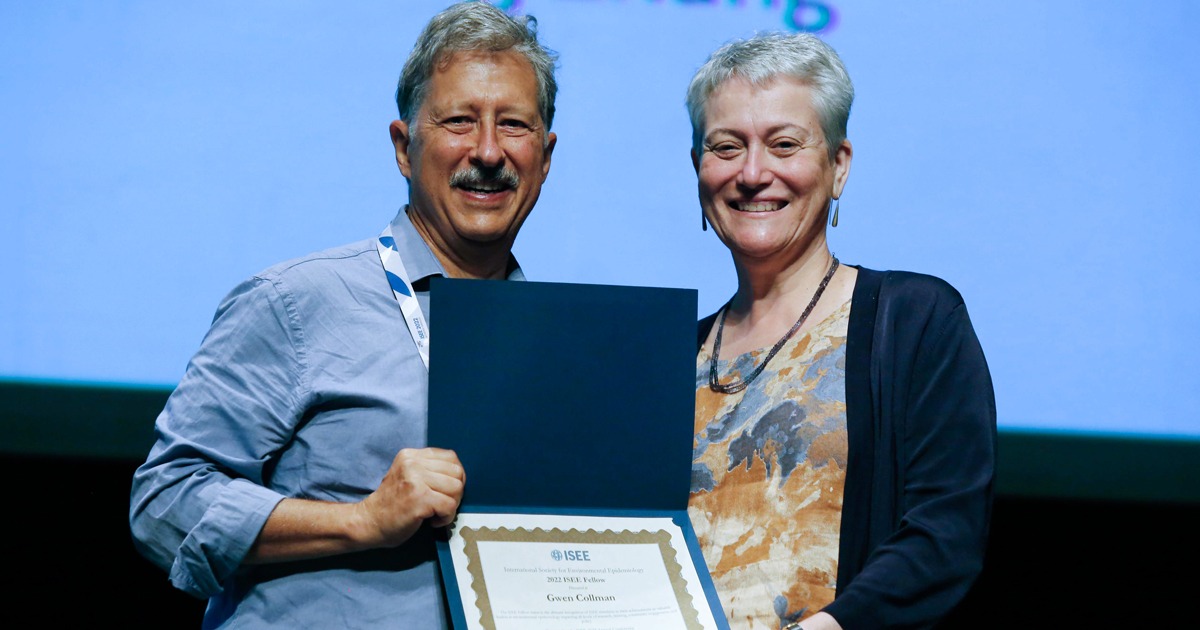NIEHS held a strong presence at the 34th Annual Conference of the International Society for Environmental Epidemiology (ISEE), held online and in-person Sept. 18-21 in Athens, Greece. Institute scientists and grant recipients presented research on climate, cancer risks, and implementing interventions for better health outcomes, among other topics.
Gwen Collman, Ph.D., director of the NIEHS Office of Scientific Coordination, Planning, and Evaluation (SCOPE), was recognized at the conference as a 2022 ISEE Fellow, the first elected cohort. She is one of four elected ISEE Fellows from around the world. In her role at NIEHS, Collman applies both scientific and business management perspectives to the development and implementation of scientific research goals and program objectives.
She was recognized as an ISEE Fellow for her achievements as an environmental epidemiologist impacting research, training, community engagement, translation, and policy. The designation reflects the valuable service rendered by an honoree to the Society, according to ISEE.
“Being an active member of ISEE has been a very important part of my professional life,” said Collman. “The ISEE meetings have provided important opportunities for me to meet and share information about NIEHS with researchers across all career stages from all over the world. I have built many long-lasting relationships during these meetings. It is quite an honor to be recognized as a Fellow of ISEE.”
Climate change and health
The National Institutes of Health (NIH) Climate Change and Health Initiative was jointly presented by Collman and Aubrey Miller, M.D., NIEHS deputy director of scientific coordination. The session, titled “A new era in global climate change and human health research funding and action,” featured three other governmental agencies — the U.S. Environmental Protection Agency, the Centers for Disease Control and Prevention, and the European Commission.
The NIH-wide Climate Change and Health (CCH) Initiative is an urgent, cross-cutting effort led by NIEHS SCOPE to reduce health threats from climate change across the lifespan and build health resilience in individuals, communities, and nations around the world, especially among those at highest risk. Several funding initiatives are underway.
The initiative is already making headway among the scientific community, as demonstrated by many oral and poster presentations on the health impacts of heat, extreme weather events, and other climate drivers. Moreover, plenary sessions focused on health co-benefits from mitigation research on climate change. Read more about the CCH Initiative.
“This work continues to grow, and environmental epidemiologists have an important role to play in these studies, and in translating their results,” said Collman.
Excess deaths after tropical cyclones in the United States, and the associations between mental health and rising temperatures in New York, were presented by NIEHS postdoctoral researcher Robbie Parks, Ph.D., an environmental epidemiologist.
Parks is an NIEHS K99/R00 Pathway to Independence Awardee. The grant will help fund his lab when he begins his new position as assistant professor of environmental health sciences at Columbia University in spring 2023.
“The award has been an amazing help for me to transition into an independent faculty role at Columbia University,” Parks said. “I will use the next stage of award funding to research novel assessments of the health impacts of tropical cyclones by rapidly expanding my research group.”
 Listen to this podcast to hear Martin speak about “Using Implementation Science to Move Environmental Health Discoveries into the Real-world.” (Photo courtesy of Steve McCaw / NIEHS)
Listen to this podcast to hear Martin speak about “Using Implementation Science to Move Environmental Health Discoveries into the Real-world.” (Photo courtesy of Steve McCaw / NIEHS)Parks also co-chaired a session on the environment and health in low- and middle-income countries.
Implementing change
Lindsey Martin, Ph.D., a health science administrator in the NIEHS Population Health Branch, facilitated a half-day workshop at ISEE to discuss how implementation science (IS) can be applied to environmental health issues in the U.S. and globally.
Martin presented an overview of IS that included the following topics.
- Defining IS and applying it to environmental health issues.
- Theories and frameworks.
- Study designs and methods.
- Implementation strategies.
- Implementation outcomes.
- Policy.
- Tips for writing IS grant applications.
- Current NIH funding opportunities for IS.
“There is a critical need for implementation science in the field of environmental health to help us close the gap between research and practice and improve population health,” said Martin. “The ISEE pre-conference workshop was a great opportunity to provide an introduction to the field and how it can be applied to the environmental health sciences across global contexts.”
Environmental cancer risks
Conference attendees learned about the activities of the NIEHS Office of the Report on Carcinogens. That congressionally mandated report identifies substances or exposure circumstances that are known or reasonably anticipated to cause cancer in humans.
 Pictured left to right are Abee Boyles, Ph.D., Bonnie Joubert, Ph.D., and Kimberly Gray, Ph.D., from the Population Health Branch, and Brittany Trottier from the Superfund Research Program, at the ISEE conference in Athens, Greece. (Photo courtesy of Lindsey Martin / NIEHS)
Pictured left to right are Abee Boyles, Ph.D., Bonnie Joubert, Ph.D., and Kimberly Gray, Ph.D., from the Population Health Branch, and Brittany Trottier from the Superfund Research Program, at the ISEE conference in Athens, Greece. (Photo courtesy of Lindsey Martin / NIEHS)- Ruth Lunn, Dr.P.H., director, shared what is new in evaluating cancer hazards during a session about health impacts and risk assessment.
- Suril Mehta, Dr.P.H., health scientist, discussed the connection between exposure to indoor wood-burning stoves and fireplaces and lung cancer, in a session about air pollution and cancer.
The connection between ambient fine particulate matter exposure and risk of incidence of breast cancer was presented by Alexandra White, Ph.D., who leads the NIEHS Environment and Cancer Epidemiology Group.
“Although air pollution has been found to increase the risk of lung cancer, we don’t have as clear of an understanding of how it may impact other cancer types,” said White.
Her research estimated levels of air pollution particles less than 2.5 microns in diameter for women’s residences.
“We found that women who lived in areas of higher exposure to fine particulate matter had a higher risk of developing breast cancer,” she said.
This year’s ISEE conference theme, “strengthening the global role of environmental epidemiology,” stressed the need to study and understand local conditions in order to build a larger, global view of environmental health challenges.
(Lindsay Key is a contract writer for the NIEHS Office of Communications and Public Liaison.)
Source link
factor.niehs.nih.gov



